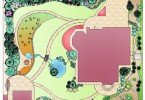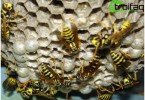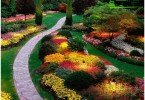Living wall as a way to fence off the street, prying eyes and active intervention in a small private world, many regard as the best option to reduce the impact of the environment on the comfort level of the estate. Such a natural shield is perceived as natural – visually positive and pleasing to the soul. Not surprisingly, the hedge in the country is increasingly becoming the center of interest for the owners of the courtyard or front garden. If the fence is preserved, then with a conditional purpose – to clearly indicate the limits of the personal space of family members.
Content
- Selection of a place – question No. 1 .
- How to make a hedge: slide gallery with hedge ideas.
- Types and choice of type and form of fencing.
- Plant selection: detailed instructions.
- The difference in the planting of tree-bush wall-fences
- Care and trimming
However, in the homestead territory more than one construction of such a pretty “line” is possible, dividing the surroundings into separate sections. And it does not have to go around the perimeter of our possessions. Quite widespread is the situation with the breakdown of country lands into several pieces, indicated in the development plan, and the necessary accents in the use of different zones for certain purposes. They really need to be somehow distinguished – with a practical, decorative purpose. Aesthetically “fit” into the landscape a fresh barrier is the best solution to such a problem.
Selection of a place – question No. 1
The starting position for summer residents who do not want to spoil the general impression of a heap of building structures is to include such “fences” in the plan project of the mini-complex, with an exact indication of their localization. Where – from a rational and artistic point of view – should they settle in? In addition to the purpose of serving as a fence-wall, these “man-made slides” have other functions: create a background for flowers, “shade” the park path, separate the rest area from the household block, block access to wind and street dust in the yard, and protect children and animals from troubles , become a guide for guests on a complex area.
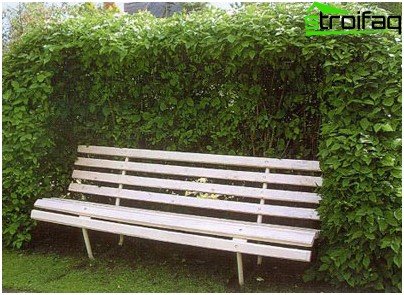
A living “backdrop” to an ordinary garden bench can decorate the garden like nothing else
For lovers of yew, barberry and dogwood, it makes sense to pay attention to shady places or those where the sun “flickers” for a short time – early in the morning or late in the evening. Boxwood, buckthorn and juniper also prefer to “live” in the shade, like hazel. The composition of the soil is no less significant: slightly acidic environments are suitable for conifers, and average acidity levels for barberry and hawthorn. Note: plants that are traditionally “selected” as the basis for creating a green “shaft” can grow to a certain width. Many need to be cut. Slender cultures will have to be planted in 2-3 lines.
How to make a hedge: slide gallery with hedge ideas
Types and choice of type and form of fencing
- The “borders” of the paths, lawns, flowerbeds are helped by low borders – a “sprout” from half a meter to a meter (occasionally and smaller).
- Green-coniferous “walls” with a height of one or two meters allow dividing the territory into certain functional zones.
- A natural rampart of two, three or more meters in height is the best way to limit the entire area.
Distinguish hedges and the intensity of cutting plants. The largest division according to this principle is freely growing and molded rows-fences. Those that are allowed to grow relatively freely become elements of landscapes created in an emphasized landscape style. They are also trimmed from time to time, but purposefully, they do not seriously cut. Trimming and cutting – the operations are different. As a result, the “shearing” of the object is given a clear geometric shape. The “shell” can be “born” the most bizarre: from angular squares-rectangles to rounded, pyramidal and complex sculptural compositions.
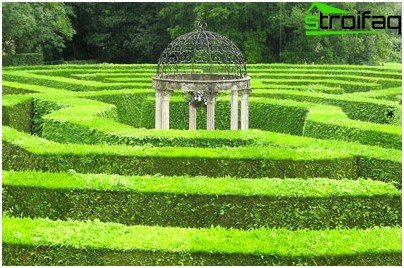
Purely decorative landscape with the help of hedges is created quite successfully
The choice of the form of the “natural” island fence is also dictated by finances. With respect to the budgetary implementation, growing a solid wall will turn out to be a much more expensive pleasure – an arched form or designer geometric shapes that are complicated – multifaceted pyramids or a chain representing the outlines of animals lined up in a line, fantastic creatures. A simple chainsaw or trimmer might not be enough to cut the “members” of such ingenious compositions. For those wishing to get acquainted with interesting ideas for creating a hedge, photos of a dozen examples from the gallery selected by us will help you choose the right project – maybe not one.
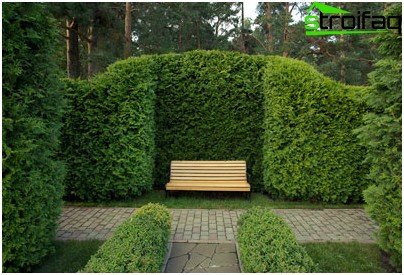
Green hedges can be modeled during the formation of complex landscape design
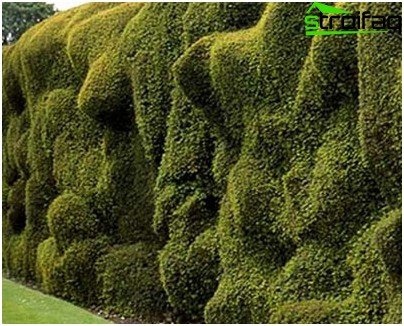
Creating a living, “breathing” series of fantastic figures is an interesting solution for a solid wall-shaft
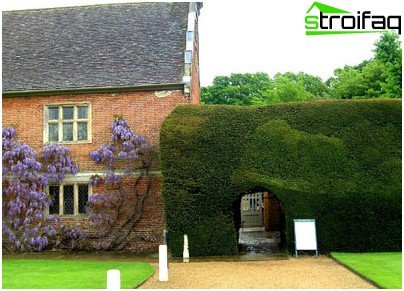
A living barrier like a fortress wall can be enormous
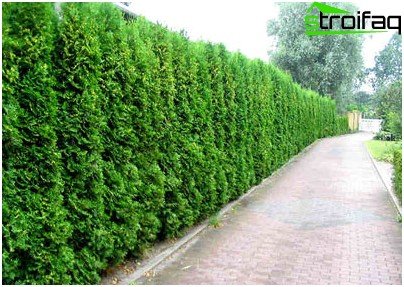
For a high wall, slender conifers are the best option
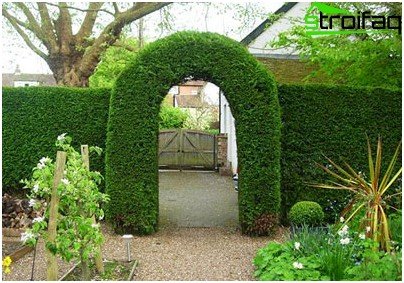
Architecturally perfect defenses “sculpt” mainly from thorny dense shrubs
Plant selection: detailed instructions
It would be nice for those who are going to “erect” a mini-border below a half meter, a growing barrier half a meter in height, to pay attention to small bush trees: alpine currant, fortune spindle tree, oval-leafed privet, purple willow, cinquefoil (Daurian or shrubby) , currant (golden or alpine), western thuja. Of the prickly breeds, barberry, sea buckthorn, wild rose, prickly thorn (blackthorn), and Japanese quince can be recommended. Decide in advance whether you would like to have an evergreen (possibly semi-evergreen) “fence” or a purely deciduous, dropping cover in the fall. This is an important clarification..
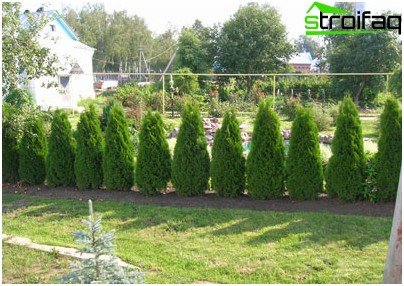
Spruce is an excellent material for a free-growing fence
If it is supposed to grow a “wall” one or two meters tall, then it makes sense to use European euonymus, goof ebbing, ordinary laurel cherry, cypress (lavson, leyland), and common privet as non-short elements. Cotoneaster with Kalinifolia cysticis, honeysuckle or lilac (both ordinary and Hungarian) will also be good. Evergreen Siberian fir, spruce (eastern, Siberian), Virgin juniper and the already mentioned variety of thuja will complete this series. From spiny juniper coniferous, sucker silver (narrow-leaved as an option), three-throated gledichia, Siberian hawthorn are suitable.
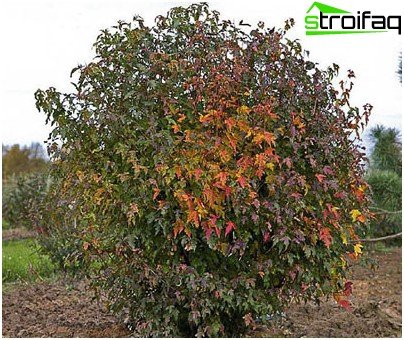
From the maple of Ginnal, wonderful hedges-walls and trellis umbrellas are obtained
Those who wish to work on the “fortress” hedge-shaft exceeding a two-meter mark will be able to plant for this purpose maple ginnal, ordinary or Siberian fir, berry apple, cherry plum, spruce from ordinary “Siberian-Canadian”. Hawthorn, buckthorn laxative, oak oak and juniper for the implementation of such a plan are also suitable. Some of these trees will be a good object for a sheared “hairstyle”. Mixed-type wall-shafts look very original. As a rule, in this case they resort to the technique of combining in one row two or three varieties of a particular species. Perfectly combine purple beech with green, privet with leaves of different colors and lengths.

Want to get a mosaic live “fence” – use multi-colored Tatar maple
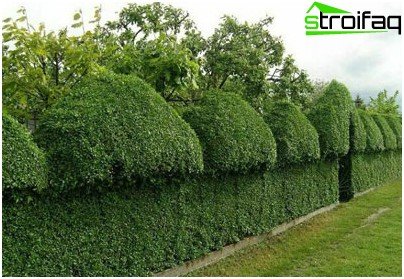
Yew crown lends itself to architectural modeling – you will definitely like this process
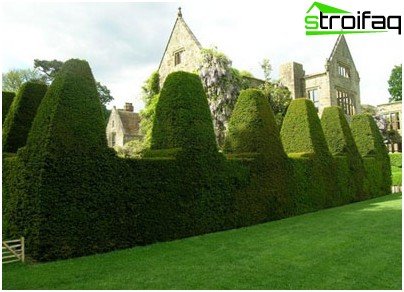
From thuja, larch, hawthorn, you can dazzle amazing hedges
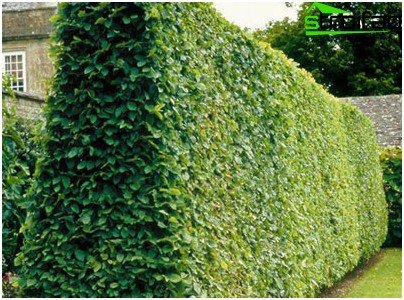
The pyramidal shape is an insurmountable “wall” – the result of working with an ordinary hornbeam
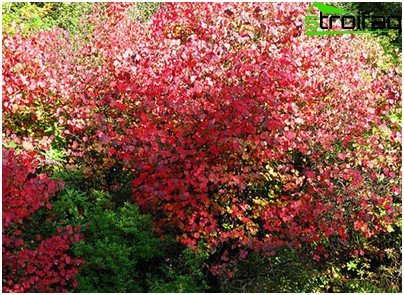
Scarlet Japanese, purple hazel forms can be used for colored hedges
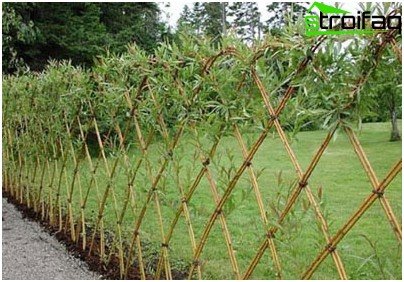
The willow hedge looks very elegant, but requires considerable design skill

This may look like your fun little fence of white derain – unpretentious and affordable culture.
The difference in the planting of tree-bush wall-fences
The easiest way is to pull the cord to begin with – and already dig a trench along it, deepening into the soil by 40-60 cm. The width of the strip depends on the number of rows. If a hedge with your own hands is planned as a single-row shield-barrier, then 40-50 cm is the norm. Another series or two is supposed – it means that each one will have to add 30-40 cm to the initial value. It is clear that the appearance and dimensions of adult crops also affect the width of the dug ditch. As well as the distance between the bushes, trees. General rules suggest: between the seedlings should remain 20-25 cm in the case of single row planting. For a double wall, it is wise to arrange the planting material in a checkerboard pattern, with a gap that fits into 30-50 cm.
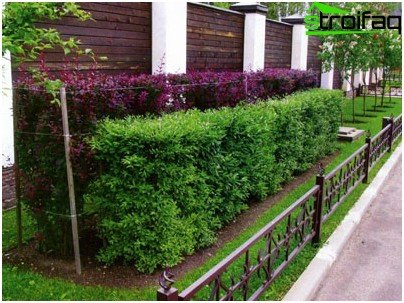
Do not forget about the possibility of combining rocks during the construction of a spectacular two-stage fence
Planting in a single line is better than breeds that produce very dense branching and copious shoots (hawthorn-currant-cotoneaster-spirea). Pair order is suitable for “living creatures” with loose branching (sea buckthorn, acacia, gledichia-goof). Before lowering a young plantlet into the pit, the “bottom” must be covered with a fertile soil layer. It is best to put compost or rotted manure at the bottom. When future bushes, trees have already settled in a trench, the soil around each should be slightly squeezed, watered and chopped, sprinkled with mulch and peat on top. When planting seedlings, it is recommended to prune. The optimal age for planting hardwood is 2-3 years. Conifers should be “older” – about 3-4 years.
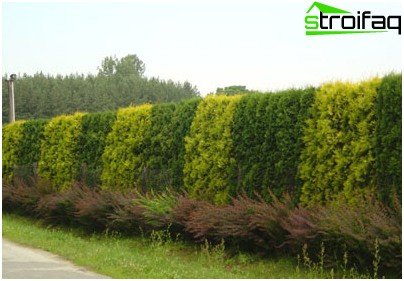
Use the maximum of imagination and industriousness – and your fabulously beautiful hedge “grows up” – multi-colored and two-row
Care and trimming
In the first year, special problems with seedlings do not arise. It is only necessary to pull out weeds. You can loosen the soil. Later, they begin to carefully trim the haircut – a couple or three times a year: during leaf fall or before the appearance of buds (that is, in autumn or spring) plus in the summer. The summer “sawn-off shotgun” (the turn of June-July, less often – August) is carried out after the growth of the shoots is stopped. Thuja and larch do not require special pruning, although you can trim the one and the other slightly – if only there would be a desire and enough imagination to imagine the final result of the effort. You need to cut on the top and sides. The tool is clippers. About a third of the annual shoot is cut off. If gaps form, in place of the dried-up participants put new, fresh.
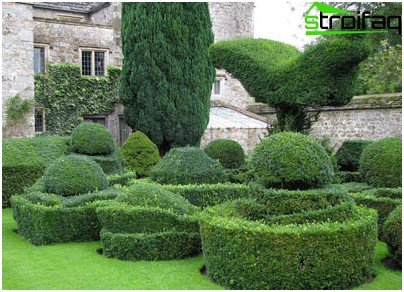
The skill to grow hedges sometimes overlaps with the art of topiary – green sculpture
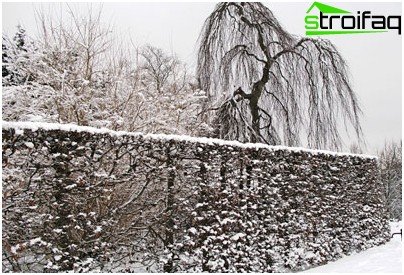
That’s how elegant your living fence will look like in winter
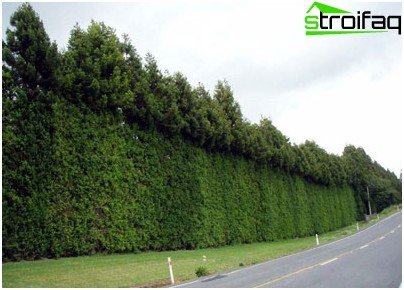
The result of partial pruning is the real fortress wall of their conifers
If you carefully take care of your living fence: feed it on time, moisten the soil in the dry period, carefully cut and trim annually, forming the crown of the desired type, your “pet” will turn into a real work of landscape gardening, delivering you a lot of positive things and the sea joys.


